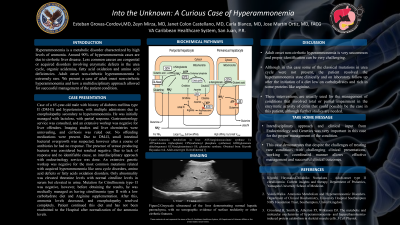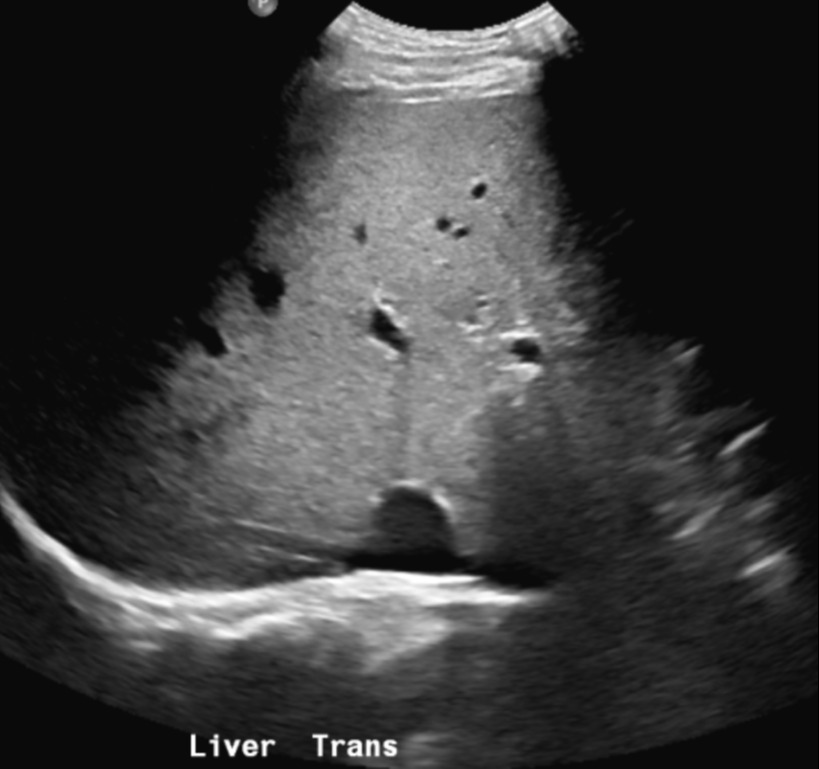Back


Poster Session B - Monday Morning
Category: Liver
B0582 - Into the Unknown: A Curious Case of Hyperammonemia
Monday, October 24, 2022
10:00 AM – 12:00 PM ET
Location: Crown Ballroom

Has Audio
- EG
Esteban Grovas-Cordovi, MD
VA Caribbean Health Care System
San Juan, PR
Presenting Author(s)
Esteban Grovas-Cordovi, MD, Zeyn Mirza, MD, Janet Colon-Castellano, MD, Carla Blanco, MD, Jose Martin Ortiz, MD, FACG
VA Caribbean Health Care System, San Juan, Puerto Rico
Introduction: Hyperammonemia is a metabolic disorder characterized by high levels of ammonia. Around 90% of hyperammonemia cases are due to cirrhotic liver disease. Less common causes are congenital or acquired disorders involving enzymatic defects in the urea cycle, organic acidemias, fatty acid oxidation and amino acid deficiencies. Adult onset non-cirrhotic hyperammonemia is extremely rare. We present a case of adult onset non-cirrhotic hyperammonemia and how a multidisciplinary approach allowed for successful management of his condition.
Case Description/Methods: Case of a 65-year-old male with history of diabetes mellitus type II (DM-II) and hypertension, with multiple admissions due to encephalopathy secondary to hyperammonemia. He was initially managed with lactulose, with partial response. Gastroenterology service was consulted and an extensive workup was negative for liver offenders. Imaging studies and liver chemistries were unrevealing and cirrhosis was ruled out. No offending medications were present. Due to DM-II, small intestinal bacterial overgrowth was suspected, however after a course of antibiotics he had no response. The presence of urease producing bacteria was considered but resulted negative. Due to lack of response and no identifiable cause, an interdisciplinary approach with endocrinology service was done. An extensive genetic workup was negative for the most common mutations related with acquired hyperammonemia like urea cycle disorders, amino acid deficits or fatty acids oxidation disorders. Only abnormality was elevated threonine levels with normal citrulline levels in serum but elevated in urine. Mutation for Citrullinemia type- II was negative, however, before obtaining the final result, he was medically managed as having citrullinemia type II with a high-protein, low carbohydrate diet and Arginine supplementation. After this, ammonia levels decreased and encephalopathy resolved completely. Patient continues on this diet and has not been readmitted and remains with normal ammonia levels. Case will be referred for further evaluation at the National Institute of Health for definitive diagnosis.
Discussion: Adult onset non-cirrhotic hyperammonemia is very uncommon and proper identification can be very challenging, making interdisciplinary approach the best option for diagnosis and management. This case reiterates the importance of a thorough clinical history, workup and interdisciplinary teamwork that can guide the treatment and resolution of challenging clinical cases.

Disclosures:
Esteban Grovas-Cordovi, MD, Zeyn Mirza, MD, Janet Colon-Castellano, MD, Carla Blanco, MD, Jose Martin Ortiz, MD, FACG. B0582 - Into the Unknown: A Curious Case of Hyperammonemia, ACG 2022 Annual Scientific Meeting Abstracts. Charlotte, NC: American College of Gastroenterology.
VA Caribbean Health Care System, San Juan, Puerto Rico
Introduction: Hyperammonemia is a metabolic disorder characterized by high levels of ammonia. Around 90% of hyperammonemia cases are due to cirrhotic liver disease. Less common causes are congenital or acquired disorders involving enzymatic defects in the urea cycle, organic acidemias, fatty acid oxidation and amino acid deficiencies. Adult onset non-cirrhotic hyperammonemia is extremely rare. We present a case of adult onset non-cirrhotic hyperammonemia and how a multidisciplinary approach allowed for successful management of his condition.
Case Description/Methods: Case of a 65-year-old male with history of diabetes mellitus type II (DM-II) and hypertension, with multiple admissions due to encephalopathy secondary to hyperammonemia. He was initially managed with lactulose, with partial response. Gastroenterology service was consulted and an extensive workup was negative for liver offenders. Imaging studies and liver chemistries were unrevealing and cirrhosis was ruled out. No offending medications were present. Due to DM-II, small intestinal bacterial overgrowth was suspected, however after a course of antibiotics he had no response. The presence of urease producing bacteria was considered but resulted negative. Due to lack of response and no identifiable cause, an interdisciplinary approach with endocrinology service was done. An extensive genetic workup was negative for the most common mutations related with acquired hyperammonemia like urea cycle disorders, amino acid deficits or fatty acids oxidation disorders. Only abnormality was elevated threonine levels with normal citrulline levels in serum but elevated in urine. Mutation for Citrullinemia type- II was negative, however, before obtaining the final result, he was medically managed as having citrullinemia type II with a high-protein, low carbohydrate diet and Arginine supplementation. After this, ammonia levels decreased and encephalopathy resolved completely. Patient continues on this diet and has not been readmitted and remains with normal ammonia levels. Case will be referred for further evaluation at the National Institute of Health for definitive diagnosis.
Discussion: Adult onset non-cirrhotic hyperammonemia is very uncommon and proper identification can be very challenging, making interdisciplinary approach the best option for diagnosis and management. This case reiterates the importance of a thorough clinical history, workup and interdisciplinary teamwork that can guide the treatment and resolution of challenging clinical cases.

Figure: Grayscale ultrasound of the liver demonstrating normal hepatic parenchyma, with no sonographic evidence of surface nodularity or other cirrhotic features.
Disclosures:
Esteban Grovas-Cordovi indicated no relevant financial relationships.
Zeyn Mirza indicated no relevant financial relationships.
Janet Colon-Castellano indicated no relevant financial relationships.
Carla Blanco indicated no relevant financial relationships.
Jose Martin Ortiz indicated no relevant financial relationships.
Esteban Grovas-Cordovi, MD, Zeyn Mirza, MD, Janet Colon-Castellano, MD, Carla Blanco, MD, Jose Martin Ortiz, MD, FACG. B0582 - Into the Unknown: A Curious Case of Hyperammonemia, ACG 2022 Annual Scientific Meeting Abstracts. Charlotte, NC: American College of Gastroenterology.

